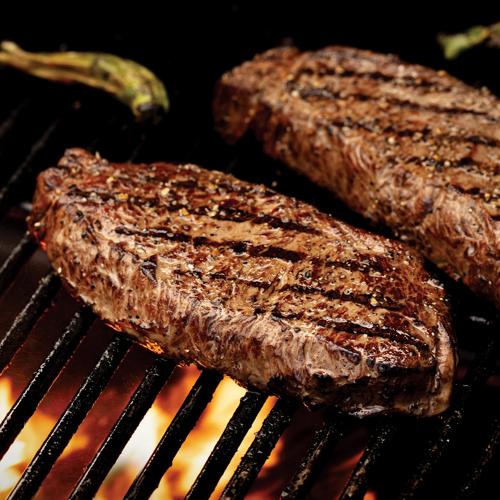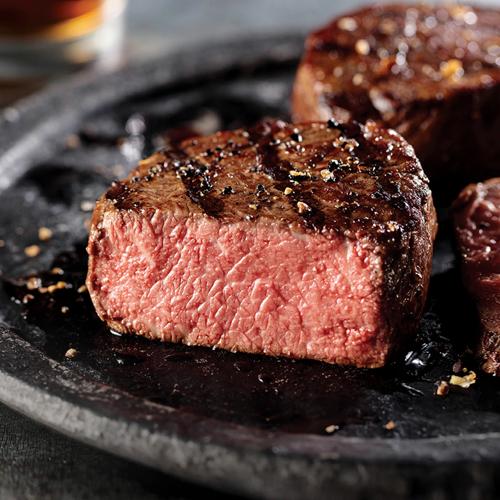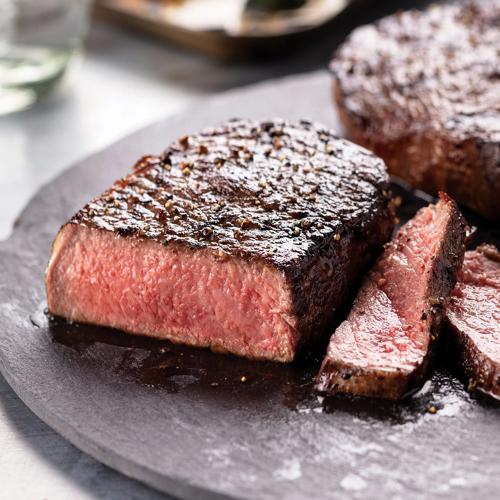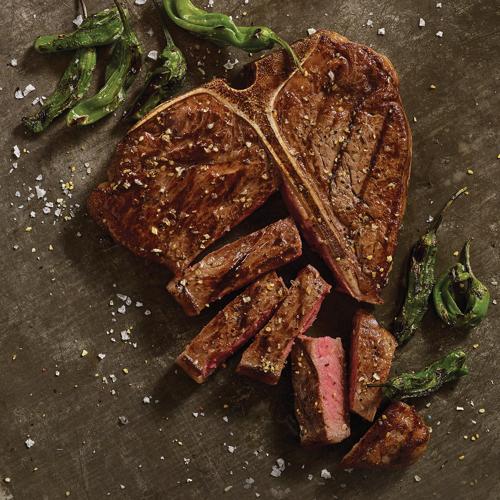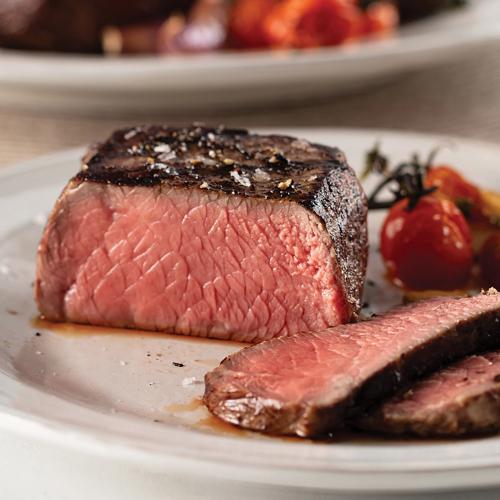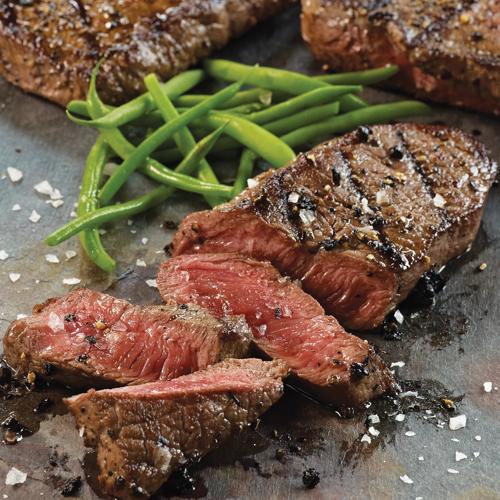
Ultimate Steak Guide – Choosing the Best Steak Cuts
- by Omaha Steaks
- Last updated Mar 13, 2025
It might seem difficult to choose the perfect cut of steak, but it doesn’t have to be with this guide to steak cuts. All it takes is an understanding of the differences – this guide will help you find yours. From tender to firm textures and bold to mild beef flavors, this guide will help you choose the best steak for your taste or recipe.
There are, of course, many more cuts of beef than are in this guide. The focus here is on the very best steaks – premium cuts of steak with unique flavor profiles and degrees of tenderness that are usually eaten simply seasoned and cooked. Do you prefer a mild, tender steak or a robust, beefy flavor with more bite? Here’s what gives each steak its unique flavor profile and tenderness and how to choose which of the steak cuts are right for you.
Which Cut of Steak is Best?
These are the best of the best – the six steaks most known for exceptional flavor and tenderness. These are the steaks that Omaha Steaks and our customers love most… but they’re not the same!
The Ultimate Steak Cut Chart
Every steak cut has a unique flavor and texture. Want to compare filet mignon vs. flat iron, ribeye vs. top sirloin, or New York strip vs. T-bone? Use our guide and chart to understand the differences between each steak and discover the best cut for your personal preference.

How to Choose the Best Types of Steak
Before we delve into the steak cut guide, let’s discuss individual steak cuts, it’s important to understand what makes a steak tender and flavorful – not all cuts of steak are created equal. There are several factors that influence the texture and taste of each steak.
- Location. The location on the animal determines the tenderness of the steak. The less a muscle is used, the less connective tissue it has, resulting in a more tender cut. Many great cuts of steak come from the loin section of the animal – not used very much and well-known for its tenderness.
- Marbling. The concentration of marbling – the little white flecks and lines of intramuscular fat – add juiciness and tenderness to a steak when it cooks. The fat melts into the steak adding robust flavor, richness, and texture. Fantastic marbling offers a great steak experience.
- Aging. Aging beef means letting it sit, in controlled conditions, after it’s been cut. As it ages, the toughness of the tissue naturally starts to break down, creating more tenderness. Omaha Steaks are wet-aged for a minimum of 28 days for maximum tenderness. We also offer dry aged steaks – a traditional butcher’s technique that is rarely done these days. It’s a long process – a full 60 days of aging – in very controlled conditions that gives beef rich, earthy flavors.
- Diet of the animal. There is a lot of discussion these days about grass-fed vs. grain-fed. Here’s the scoop – all American beef is grass-fed in pasture. The difference is whether or not the animals are “finished” on grain, which means fed a heartier grain-fed diet before they are harvested. So the debate is really grass-fed only or grass-fed-grain-finished are both delicious steak options. A grass-fed only diet will result in a leaner cut of meat with less marbling. If you prefer superior marbling and texture, grain-finished will provide that experience. We offer both options of steak and it is a personal preference.
Beef Cut Chart
For a quick reference, this chart shows where each cut of Omaha Steaks beef comes from on the cow. The most tender cuts of steak come for the rib and loin areas, including the tenderloin, short loin, and top sirloin.


The filet mignon is designed to impress. This decadent steak, cut from the tenderloin, is known for exceptional tenderness and mild beef flavor. Although incredibly tender, filet mignon actually has less marbling compared to the New York strip or ribeye. But cook a good filet mignon right and it’s more tender than any – you can cut it with a dull butter knife. The mild flavor and low marbling of the filet make it a great compliment for seasonings, sauces, or a bacon wrap, and it’s best cooked rare to medium-rare.
Learn more about this decadent steak in our filet mignon butcher’s guide.
Ribeye

The ribeye is a favorite among steak enthusiasts. This cut has fantastic marbling which melts into the steak as it cooks, adding richness and juiciness. The ribeye has a rich, buttery flavor and tender texture. Cook to a perfect medium-rare with a fast cooking method using high heat to get a great sear without overcooking.
Learn more about this restaurant favorite in our ribeye butcher’s guide.
New York Strip

The New York Strip is considered the ultimate grilling steak with a firmer texture and rich marbling. It has the boldest, beefiest flavor of all the steak cuts in this guide with a great bite. The New York strip steak is delicious eating experience and is best cooked on a super-hot grill, pan-roasted, or reverse-seared.
Learn more about this grilling favorite in our New York strip butcher’s guide.
T-bone & Porterhouse

A T-bone is a classic steak with an iconic shape. It’s actually two steaks in one – the filet mignon and New York strip – separated by a T-shaped bone. When you buy a T-Bone you get the bold, beefy flavor of a New York strip and a mild, tender filet mignon. A porterhouse is technically still a T-bone, but has a full-size filet portion with a minimum of 1.25-inch filet measured from the widest point. The T-bone is an impressive steak that gives you two unique steak flavor profiles.
Learn more about the king of steaks in our T-bone butcher’s guide.
Top Sirloin

The top sirloin is a naturally lean, thick cut of steak with a bold, beefy flavor. Cut from the top section of the sirloin primal, top sirloin is delicious on its own, adds rich flavor to recipes, and cooks well with marinades and sauces. This naturally firm steak is tenderized by aging, creating a perfect lean protein steak cut that tastes delicious. Because of the leanness of this steak, avoid overcooking for maximum tenderness. We recommend cooking to a medium-rare temperature for the best dining experience. The top sirloin is an affordable cut making it a great ‘weeknight’ steak.
Learn more about this lean, delicious steak In our top sirloin butcher’s guide.
Flat Iron

The flat iron is an innovative newer steak, cut from the top blade of the chuck. It is the 2nd most tender steak (only filet mignon is more tender) and has big, bold beefy flavor. It has fantastic marbling and a tender texture and is gaining popularity among steak enthusiasts. The flat iron is great in recipes, and can be enjoyed on its own grilled, broiled or pan-fried to a perfect medium-rare. If you haven’t tried flat iron yet, we’re betting it will be your new favorite.
Learn more about this unique steak cut in our flat iron butcher’s guide.
Cooking Steak
No matter which steak cut you choose, it’s important to nail the internal temperature for a juicy, delicious restaurant-worthy steak. Our steak doneness guide will show you which steak temps will give you the right cook for your taste buds. And use our steak cooking chart to find the right cooking temps and times to achieve the doneness you want.
Buying the Best Steak Cut
A great dining experience starts with exceptional beef. You can read Omaha Steaks reviews to see what our customers have to say about our steaks. Our team of master butchers cut the six steaks discussed in this steak cut guide and so much more. From tender to firm and bold to mild beef flavors, find your new favorite beef cuts at Omaha Steaks with a delicious steak package.
More Like This

Full Steak Collection
Each steak is aged at least 28 days and hand-carved by master butchers.

18 Steakhouse Recipes
Bring the steakhouse to your house whenever the craving hits with our chef-created recipes.

The Ultimate Guide to Cooking Steak
This guide will give you the confidence to cook the perfect steak indoors or outdoors every time.

Steaks for Everyone
Omaha Steaks are hand carved from the best in grass-fed, grain-finished beef and then carefully aged at least 28+ days to maximize tenderness.
